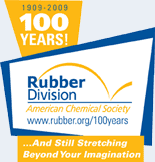![[ Visit ACS Rubber Website ]](images/logo.jpg) |
|
|
Wednesday, April 20, 2011: 10:00 AM
Akron/Summit Ballroom (Akron/Fairlawn Hilton Hotel)
In this study, the interfacial reaction effect on morphology, continuity
development and co-continuity in reactive blends of poly(isobutylene-co- p-methylstyrene) (BIMSM) and polyamide (PA) containing different amounts of plasticizer without vulcanization is examined. The interfacial reaction was found to be effective in dispersing blend components down to 50–80 nm fine droplets and to produce high amounts, about 46%, of the interfacial graft copolymer. This copolymer amount can be even higher, up to 57%, in a plasticized blend. The reaction between the elastomer and PA shifts the percolation thresholds and overall continuity development to higher concentrations, but no effect can be observed on the concentration region of dual-phase continuity. It is found that the dominant factor in controlling the dispersion of higher amounts of BIMSM elastomer into the PA phase is the extent of reaction between BIMSM and PA. |
